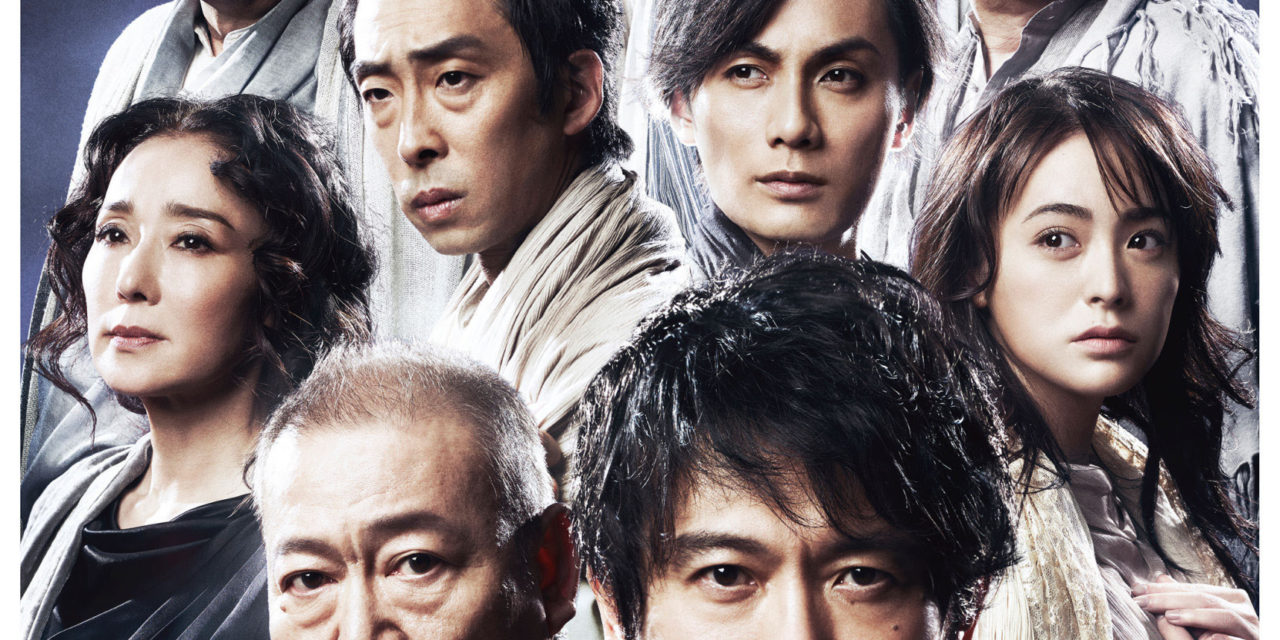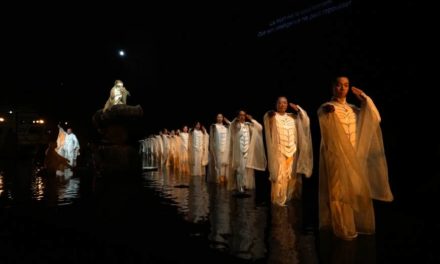John Caird is widely known as the co-director with fellow Englishman Trevor Nunn of Les Miserables, which opened in the West End 1985 and is still playing there in the longest-ever London run for a musical.
However, Caird’s illustrious career as a writer and director also spans opera and contemporary theater — though as his honorary associate director position at the Royal Shakespeare Company suggests, his forte is the Bard.
Indeed, as recently as this February the Daily Telegraph’s theater critic Dominic Cavendish singled out Caird’s Hamlet at the National Theatre in London in 2000, and his casting of Simon Russell Beale as an unusually sweet and studious Prince of Denmark, for top spot in an article titled “The 10 great Hamlets of our time” — and that despite “Tubby or not tubby” being a popular quip about its slightly portly star.
Well now, theater lovers in Japan have the great good fortune of being able to see Caird’s first-ever Hamlet since then, which opens April 9 at the Tokyo Metropolitan Theatre in Ikebukuro with an all-Japanese cast.
So, a month ahead of curtain-up, I called on him at a studio in downtown Tokyo to ask about the rehearsals and to talk about Bard’s towering tragedy first staged in 1602.
“Everything’s going so well. … Oops, it’s not a good Japanese attitude to say that,” he replied with a laugh — likely betraying the influence of Japanese actress Maoko Imai, his wife since 1998 and mother of their three children, who is here this time as a co-scriptwriter overseeing interpretation.
Then in a more serious vein, the 68-year-old maestro continued, saying, “This work’s often done for the wrong reasons. Many actors think they have to play Hamlet — but lots of them don’t have a Hamlet in them. So there are too many people performing this role they don’t really understand.”
Superficially, of course, Hamlet is about the Prince of Denmark (acted here by Seiyo Uchino) who swears vengeance after his uncle, Claudius (Jun Kunimura), kills his father and marries his mother, Gertrude (Yuko Asano), in order to take the throne. Then, amid madness and mayhem, Hamlet’s true love, Ophelia (Shihori Kanjiya), kills herself because she wrongly thinks he’s spurned her.
When I asked Caird why this drama is staged so often all over the world, he bluntly declared, “This is Shakespeare’s most profound philosophical play about what life is worth and the meaning of life.”
Then, pointing to some common misconceptions, he added: “The problem is that people believe Hamlet’s a young and beautiful romantic role, but it’s not. He is everyman; he is just a thinking, philosophical man.
“And this is not a normal tragedy, because Hamlet is an extraordinarily good and thoughtful person,” he went on, contrasting him with some other leading Shakespearean characters such as Coriolanus, Macbeth and Othello, who have terrible flaws of pride, ambition and jealousy.
“Many people have tried to look for the flaw in Hamlet, but there isn’t one. He is a victim of his circumstances,” Caird observed.
Despite this, he said many directors are misled into presenting this play as a naive young prince’s personal tragedy — whereas “his problem is not his personality; he’s just a man to whom some horrible things happened.
“So he is someone everybody can identify with.”
As for tragic Ophelia, Caird similarly explained, “She had a normal life snatched away from her by some terrible things that happened. Again, everybody can identify with her because we’ve all loved someone and not felt loved back.”
From there he cut to the quick, saying: “This is the most profound play ever written about the nature of existence: To be, or not to be? Do we exist, or do we not exist? Should we go on living, or should we die? How well can we live in our lives? When is it the right moment to die? What happens after we die? And what’s the difference between being alive and being dead — is it a strong wall between, or a permeable membrane?”
He continued: “The play deals with what’s the difference between reality and seeming. You think you can see what’s happening in reality, but actually, something else you’re not aware of can be happening.
“So everybody in the play is acting. Hamlet is acting as if he doesn’t know his father was killed by his uncle, and Claudius is acting as an innocent man … and so on. Everybody is required to be an actor in their daily lives and everyone is pretending. So nothing is what it seems.
“Another fascinating thing is that Shakespeare put a play within the play when some traveling actors come along and perform a version of ‘Hamlet’ that tells the murderer (Claudius) it’s obvious to everyone what he’s done. So he runs out of their performance.
“Altogether, this play’s an amazing onion of different meanings.”
Meanwhile, in his London staging in 2000, Caird experimented by having one actor play both the murdered king’s ghost and the king in the traveling troupe’s piece. This time, instead of the usual cast of around 30, he has just 14 actors, with almost all taking more than one role, “to accentuate the idea that it’s a play based on the memory of Horatio (Hamlet’s trusted friend, and the only major character to survive).
“So his actor (Yukiya Kitamura) is alone in playing just one role,” he explained.
In general, however, Caird said his “only directing recipe for Shakespeare” is to just steadily check and confirm the appropriate words with actors in the rehearsals.
“It’s all about the details,” he stressed. “Audiences want to know and need to know what the human story is. So actors don’t need to shout loud and speak fast.”
Then, somewhat arrestingly, he declared, “Shakespeare is not a visual thing.
“In English we don’t call people who go to a play ‘spectators’ — we talk about ‘audiences.’ So they listen to the words; it’s all in the language.
“If you give audiences too much visual information, they stop listening to the play and they can’t understand the relationship between the characters.”
Hence Caird has kept the sets uncluttered, while dressing the cast in simple robes. He has also enlisted shakuhachi (Japanese traditional flute) player Dozan Fujiwara — who he worked with in 2007 and ’09 on his original, smash-hit “Kinshu” based on Teru Miyamoto’s 1982 novel — to play new music he’s specially composed.
Although Japanese dramatists have come up with countless takes on Shakespeare over the years, including many superbly visual and/or offbeat ones that might have left some native English-speaking colleagues aghast, this unique, Anglo-Japanese Hamlet looks set to open even more doors in this classic exploration of the difficulty of knowing what anyone is really like.
So be ready to both hear and feel its Japanese words — and to enjoy all the fresh wonders Caird aims to present.
Hamlet runs April 9-28 at the Tokyo Metropolitan Theatre outside JR Ikebukuro Station. It then tours to Nishinomiya (Hyogo Prefecture), Kochi, Kita-Kyushu (Fukuoka), Matsumoto (Nagano), Ueda (Nagano) and Toyohashi (Aichi). For details, call 0570-010-296 or visit www.geigeki.jp.
This article was originally posted on The Japan Times. Reposted with permission of the author. To read an original article, click here.
This post was written by the author in their personal capacity.The opinions expressed in this article are the author’s own and do not reflect the view of The Theatre Times, their staff or collaborators.
This post was written by Nobuko Tanaka.
The views expressed here belong to the author and do not necessarily reflect our views and opinions.


















